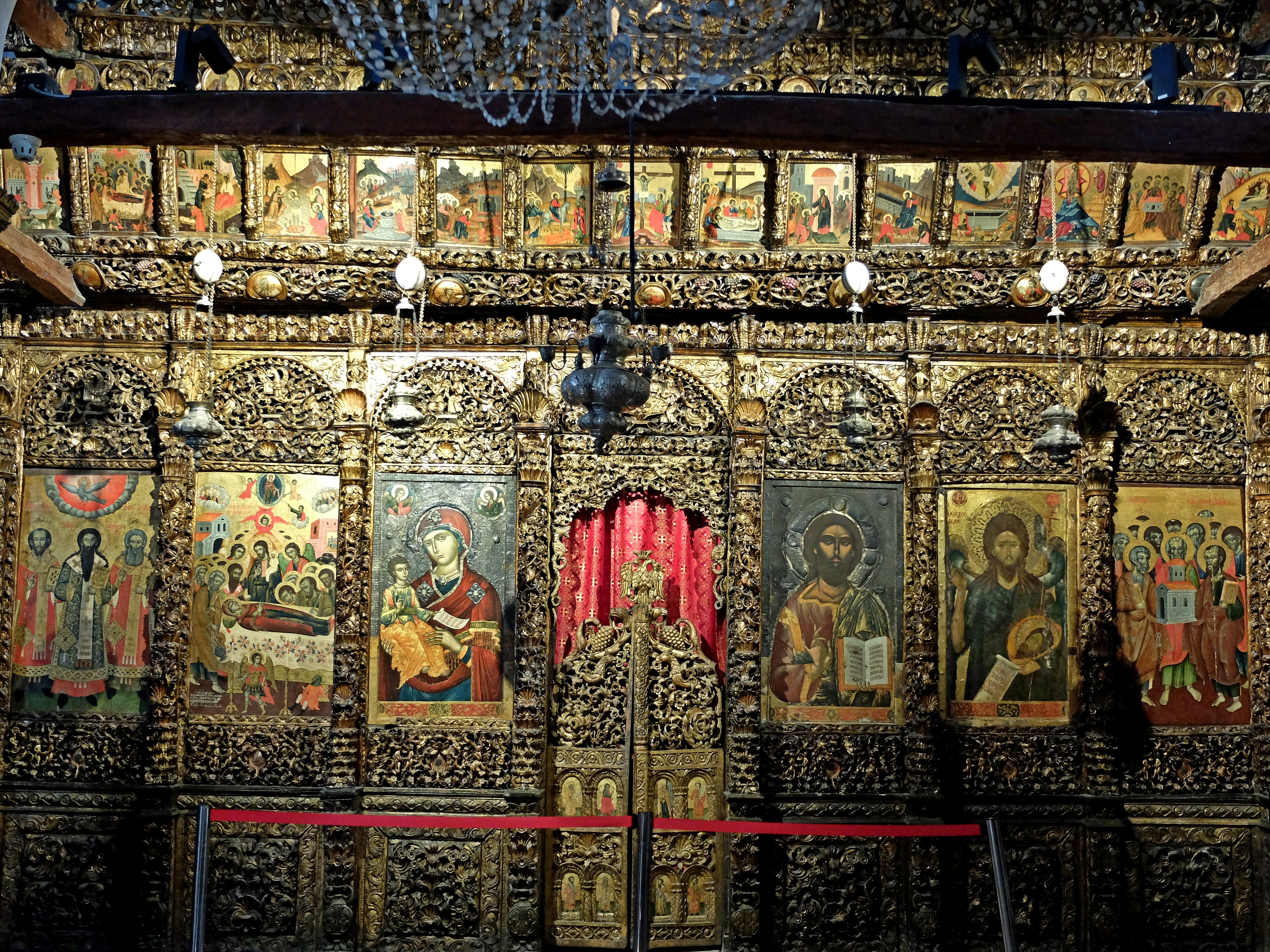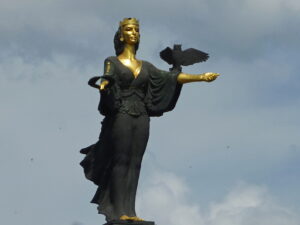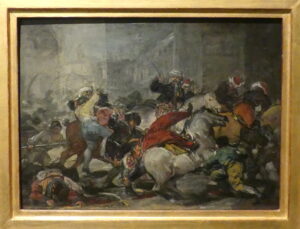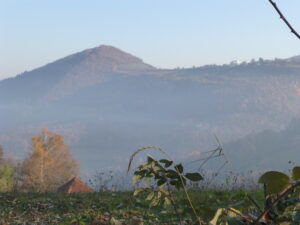
In our post about Albanian history (click here to read), we noted all the cross-currents of culture affecting the country – from its Illyrian origins, through Greek and Roman control, the influence of Byzantine and eastern Orthodox Christianity in the early Middle Ages, the onslaught of the Slavs and other tribes, Venetian control for a time during the Renaissance, as well as the occupation by the Ottomans through the 19th century and the incursions of Austro-Hungary after that.
(For a perspective on Albania today, click here to read our thoughts on traveling the country now.)
Throughout Albania, we enjoyed the challenge of tracing these cross-currents: hilltop fortifications and old coastal towns with remnants of past empires, notably in Shkoder, Durres (Tirana), Butrint and Berat – foundations that were Illyrian, Roman construction upon them (making towns noted by Cicero and Vergil 2000 years ago), walls from Venetian modifications, Byzantine adaptations and finally Ottoman reconstruction. Or places like Apollonia that all but disappeared after the middle ages.

At the seaside resort of Durres, for example, we explored a large Roman amphitheater, set within walled fortifications begun by the Illyrians. Its walkable walls date from Venetian control with enhancements afterwards by the Ottomans.
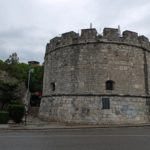
Within one section of the theatre, where attendees would enter, early Christians built a small chapel in Byzantine style. Frescoes from that chapel still adorn the walls.

By contrast, Apollonia is barely a village now, but it flourished historically as a vibrant hillside town through the middle ages. The extensive archeological remains trace back to the old Illyrian town, then the occupation by Hellenic culture. The agora and a meeting hall from that time are still evident.

The hall’s façade dominates the area, dazzlingly reconstructed by archeologists. Romans then created a mini-Rome out here to civilize the Balkans and manage trade from the area. We could walk the agora that the Romans turned into a porticoed marketplace, and examine repurposed temples now just visible as low stone walls. Some floor mosaics from the time survived until unearthed by archeologists, but for now they are covered in sheeting and pebbles to protect them.
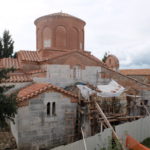
In the Middle Ages, religious leaders built a large Byzantine-style temple in one part of the complex. It’s still in fine shape. The adjacent museum follows the sweep of this history with artifacts from 600 BC forward.
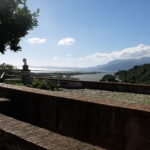
Into the 18th and 19th century, Butrint (Roman Buthrotum) occupied a strategic position on the large bay to its east and in sight of the narrow straits between the mainland and Corfu. Atop the prominent hill, an Ottoman fort adapted from a Venetian original, we could still watch over these waters. At the fort, another museum traces the evolution of cultures with artifacts from the site.
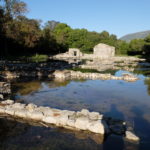
Closer to sea level, we ambled around the foundations and a few walls of an Ottoman palace; across the bay mouth, a crumbling defensive fort of the Pasha once added protection.
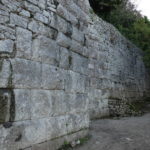
Two thousand years earlier Illyrian Butrint was renowned for its similarity to Troy. Vergil writes of Aeneas stopping here to visit Andromache, Hector’s wife, and marveling at how town revived Trojan style in architecture and practices. He would have entered by the Lake Gate, a modestly decorated portal within a stone wall made of massive blocks of limestone. They call it Cyclopean, as later occupants could only imagine giants moving these blocks into place.

Nearby, the empty stone walls of a basilica and columns of a baptistery affirm Christianity’s presence from about 600AD on. Here too the old mosaics are covered by stones and…water. We visited Butrint after some serious rain, so much of the base of the antiquities was flooded, though the algae we saw suggested this happened often.
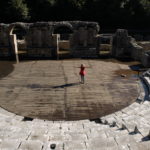
Within the city, a delightful array of walls and partial structures attest to the old civilization. The best was the theatre, a seemingly small jewel in horseshoe shape that became a lot larger once you went inside it. Because of the flooding, we had to tightrope along the ragged tops of adjacent walls to get there, but it was worth it. We could also view carved inscriptions in the stone benches dating from the Hellenic period announcing in Greek a freeing of slaves and proclaiming the moneyed patrons of the theatre.
Ruins like these require a good deal of imagination and historical explanation to come alive. But Albania also offers a living history of its nearly half-century Ottoman heritage at the well preserved towns of Gjirokastra and Berat. There you can walk the cobblestone streets, gawk at vintage buildings that continue to be lived in, and feel you stepped back several hundred years.
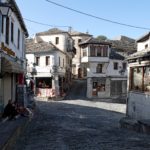
Gjirokastra town is filled with 600 Ottoman-era houses roofed with slate plates and heaped on a set of steep hills, with many dating from the 17th century. Above it, a less interesting castle floats atop the hills. The center of town is compact, just a few blocks in all directions from the cobblestone intersection. It’s quite atmospheric and picturesque even though contemporary shops and pizza places have unobtrusively replaced the old stores.
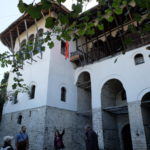
Only a couple of the houses can be toured inside, and act as ethnographic museums demonstrating the old lifestyles. We had a wonderful tour of the Skenduli House, which accommodated 25 or so of an extended family in its three floors. Each room had specific purposes like guest bedrooms, single sex gathering places or wedding celebrations.
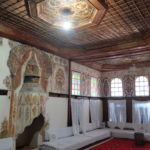
These were all interconnected by central hallways as well as back passageways so women could serve the guests while remaining hidden. Lots of “Turkish” toilets and decorative built-in storage cabinets complemented the main rooms. The two-tower Zekate House farther uphill rose up from a walled garden and gave its residents a panoramic view over the entire valley. It was designed similarly, underscoring the common culture of the time.

To the north, Berat also lets you walk through history with a well-preserved old city full of Ottoman architecture, a few stone ruins as reminders of the past and some exquisitely decorated mosques. We even stayed in a hotel formed from two Ottoman houses, renovated for the purpose, but still retaining the charms of the original.
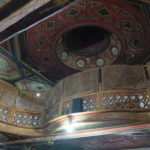
The mosques date from the early Ottoman days up to about 1800. They survived communist destruction of religious institutions because of their cultural and artistic value. The three we saw in the old city needed repairs and cleaning, but their exterior and interior décor was as enchanting as any we had seen throughout eastern Europe. One teqe was filled with extensive woodwork to marvel at.
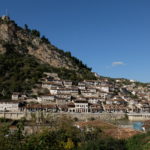
By contrast, the Gorica section across from the old town was much more like a medieval hillside village, with stone houses on the narrow lanes that cut across the hill and steeply pitched streets and steps rising to higher lanes. There you could thoroughly enjoy a panoramic view back to the old town, with the Berat castle stalwartly above and a brick St. Michael church notched into the hillside below it.
That castle offers one of the best examples of a living antiquity. In the middle ages, people often built homes within what remained from a Roman theatre or, more evidently, an oval coliseum. That’s what happened at Berat Castle. Villagers live in stone buildings often formed from the old walls and structures up there, and still gather in the many small churches that served the people from the Byzantine past till today.
We saw many of today’s residents, some of whom sold items to the tourists and others who farmed or tended herds in the mountains. We met one of its older residents on the long cobblestone road leading up to the castle. Though weighed down with a few bags of groceries, he had stopped at a barely discernible goat path heading straight up toward the castle. In a mix of Italian, English and Albanian he alerted us to this alternate trail. Non pagare. Non pagare, he encouraged us. So we followed him, though he sped up the steep trail more ably than we.
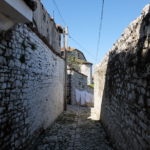
Another villager, staked out at the run-down church of St. George with home grown oranges and pomegranates for sale, happily directed us in more Italian to the view from a platform area just below. He was unaware we had snuck in by the back door – or rather goat path – so we had already passed that viewpoint, but he was right. He also helped us find our way around the confusing tangle of ruins and streets in the main part of the castle. We appreciated his attention.
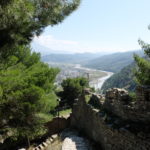
His overlook – and then our later view over the 200-meter deep valley at the other side of the castle ridge – proved to be more appealing than the ruins for the most part.
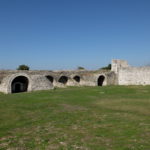
You could track down most of the historical Albanian cross-currents in the rubbly walls with Illyrian foundations, a brick minaret from an old mosque, a Greek agora/acropolis with just a few stall sections remaining, plus an impressive walled portal still standing. Also intriguing was a vast cistern, actually a brick building whose stepped entrance suddenly dropped off into its deep enclosed well.
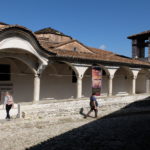
As you walk the narrow stony lanes and relish the stonework buildings still occupied by villagers, you can also find, with some difficulty, a half dozen or so small churches that arose while the town filled in the castle fortifications. From the outside, these churches were grand and stolid reminders of the spread of Eastern Orthodoxy before the Ottomans. Sadly, other than the drab St. George, none of them were open to view except for the Church of the Dormition of St. Mary, now re-purposed as the Onufri Museum.

This Byzantine style church in the midst of the castle village has an impressive church interior, most notably its huge wood carved and gilded iconostasis filled with three tiers of wondrous icons. About a sixth of the museum’s extensive collection of icons, many by the icon master Onufri and his sons, have been gathered from the other churches here. They fill the rest of the building.

We stopped for a few drinks at a friendly cafe near the portal walls, the correct entrance to the castle, and watched visitors come and go, trying to figure out where to head in the confusing tangle of streets. We ambled back through the village, and headed down the goat path we had taken up. We met only a few tourists from the Americas who also had been tipped off about the path. We offered them some pointers about finding things once they reached the castle.
For it’s a challenge to find one’s way through the ancient castle streets. Just as it’s a challenge to trace all those historical cross-currents that are embodied in Albania’s antiquities and that formed the Albania of today.
(Also, for more pictures from Albania, CLICK HERE to view the slideshow at the end of the itinerary page.)


